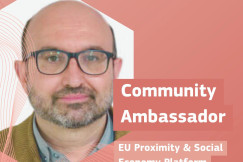Articles
18 April 2025
Cities@Heart: the Greater Paris Metropolis leads a network of ten European partners focused on sharing best practices and innovations for improving city centre management
Articles
18 April 2025
Urban and Rural Wellbeing
Proximity and social economy
15-minute city
+2 more
Login / create an account to be able to react
-
17
Greater Paris Metropolis
Topics
Belgium
Croatia
France
Greece
Ireland
Italy
Poland
Portugal
Slovenia
Spain
Local Authorities
-
Thematic area
-
-
Urban and Rural Wellbeing
-
-
Interlinkages with other sectors
-
-
Proximity and social economy
-
-
Action areas and keywords
-
-
15-minute city
-
-
Ecosystem focus
-
-
Proximity economy
-
-
Scope of activity
-
-
International
-
Share
Having a chat with your neighbourhood baker, running into an old friend, finding all you need in one place: these are just some of the reasons why we feel so attached to our city centres. However, in the 21st century, city centres are facing more than just a little competition. From the rise of big-box stores and franchises to the omnipresence of online commerce, downtown areas have lost some of their edge.
Driven by urban sprawl and rising property values, the spatial fragmentation of cities further strains the resilience of the high street. Amid all these challenges, city centres are well worth understanding, defending and improving. That is where the URBACT Cities@Heart Action Planning Network comes in.
Supported by the European Regional Development Fund (ERDF), URBACT promotes sustainable urban development in Europe’s cities, both big and small. The Greater Paris Metropolis (Métropole du Grand Paris, France) coordinates the network in the role of Lead Partner. With a strong track record in downtown revitalisation policy, the Greater Paris Metropolis is a public entity representing 130 cities in the French capital region, including the city of Paris. Endowed with extensive experience in local economy, architecture and urban planning, Barcelona-based Mar Santamaria Varas assists the network as Lead Expert.
Each partner in the network is facing their own challenges: loss of inhabitants to the peripheries or the metropolitan areas, underdeveloped local commerce networks, the transition to walkable and car-free environments, gentrification and over-tourism, gender equality and inclusion, etc. Yet, all partners can agree on one thing: city centres are unique places and not just because they hold a certain affective charm; they truly are the life force of our urban societies. Keeping the heart of downtown healthy is key to ensuring the vibrancy of local economies and the well-being of inhabitants.
As a response to this multifaceted challenge of city centre management, Cities@Heart proposes the creation of a shared methodology applicable to different types of urban contexts. Relying on a bottom-up approach that integrates data management, this accessible, user-friendly framework will support decision-making processes as well as the implementation and efficiency of cross-cutting sustainable urban policies.
The Cities@Heart methodology is based on five fundamental pillars:
Governance: Exploring existing models of town centre management (public vs. private, formal vs. informal) and new paradigms of participatory agreements among stakeholders in the form of multi-level partnership;
Integrated Public Policies: Deploying policies that cut across multiple policy domains (housing, public services, mobility, public space, commerce, etc.);
Decision-Making Tools: Integrating data and indicators to support the analysis, formulation, and monitoring of implemented actions;
Sustainability: Ensuring urban centres can adapt to climate change despite facing greater difficulties in comparison to the rest of the city (such as scarcity and limited space in public areas, a poorly maintained built environment, household incomes incapable of coping with transformation, etc.);
Inclusion: Providing optimal living conditions for all residents (regardless of gender, age, or background) and promoting personal autonomy through inclusive care.
Today, city centres still represent an opportunity to address structural challenges in the transition to new urban models fuelled by the green transition and grounded in the principles of proximity. As proposed by urbanist Carlos Moreno in the 15 minute-city paradigm, town centres have the potential to provide most essential services within a short walking distance: community-scale education and healthcare, retail, parks for recreation, working spaces and more. This hyper-local framework has the potential to generate dynamic local growth, stronger communities, viable businesses and commerce, active mobility, and in turn reduced emissions.
An interdisciplinary and complex subject, city centres are certainly worth examining closely. Observing the core of the city provides insight to broader national and global trends. Addressing social and urbanistic issues in the city centre may in turn yield more positive effects on the greater urban area, creating more spaces for people to meet and create engagement in their communities.
Created in June 2023, the network’s activity will come to a close in 2025. Network activities are regularly posted on the URBACT website and on the Cities@Heart LinkedIn page.
The ten network partners include:
The Greater Paris Metropolis, France (Lead Partner)
The City of Cesena, Italy
The City of Granada, Spain
The City of Osijek, Croatia
Amfiktyonies, a business development organisation representing the City of Lamia, Greece
The City of Celje, Slovenia
The City of Fleurus, Belgium
The City of Sligo, Ireland
The Krakow Metropolis Association, Poland
The Quadrilátero Urbano Association, Portugal
Comments (0)
See also
-
4
Urban and Rural Wellbeing Highlights: December 2024 and January 2025
- Categories
- Proximity and social economy Agri-food Construction +62 more
-
3
Urban and Rural Wellbeing Highlights: February and March 2025
- Categories
- Proximity and social economy 15-minute city Access to Finance +48 more
-
26
PSE Platform Ambassador highlight: Josep Xurigué Camprubí and Vitrines d’Europe
- Categories
- Proximity and social economy Construction Cultural and creative industries +38 more




